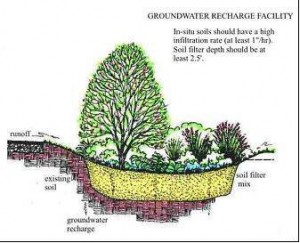by Tom Barry
Stormwater runoff has become an increasing environmental concern as urbanization of our society has created massive areas of impervious surfaces that flood our storm drains and waterways with pollutant laden water. Stormwater management techniques are gaining popularity in urban environments to offset this “paved paradise” syndrome. One of the techniques that has shown promise is bioretention. Bioretention cells are depressions in the landscape that capture stormwater before it can enter waterways. Stormwater is collected and percolated back down into the ground where it is filtered through a media. The components of this media, or bioretention soil, play an important role in the success or failure of the cell. Ongoing research and technology has increased the capabilities of these soils to succeed.

Bioretention soils must have sufficient infiltration rates to prevent ponding on the surface for over 48 hours.
Traditionally, bioretention soils are made up of three components: sand, soil and compost. However, specifications vary dramatically on the ratios of each from project to project. This has been the case largely due to the lack of scientific evidence suggesting ideal ratios. Additionally, each bioretention cell may have different requirements. There are, however, certain performance criteria that have been found to be universal for all bioretention soils. These criteria include:
- High percolation rates to prevent surface ponding over 48 hours
- Large capacity to sequester pollutants as water percolates through
- Support for the growth of plant populations
These criteria take a simple concept of sand, soil and compost and turn it into a complex system requiring constant quality control. In order to prevent adding the same pollutants in stormwater to the bioretention soil, each component must be tested diligently. Additionally, sources for each component will affect how these soils perform. For example, mature leaf compost typically serves as a better compost source than manure or yard waste compost because of its lower nutrient levels. In other words, bioretention soils are meant to serve as a solution to the problem not be a contributor. Therefore, careful attention needs to be paid to avoid this.
Recently, attention has been focused on dissolved nutrient levels as a major concern in stormwater runoff, in particular phosphorus. Phosphorus is the main cause of eutrophication in most freshwater lakes and streams. Even low levels of phosphorus can stimulate the growth of algal blooms resulting in hypoxic conditions and high mortality rates of aquatic organisms. To address these concerns, there has been a tremendous amount of research performed throughout the country looking for ways to maximize bioretention soil’s capacity to sequester phosphorus. Additionally, new technology is being developed to capture dissolved phosphorus as it percolates through the soil.
Stormwater management techniques, such as bioretention, have become a component of every new design in urban landscape architecture and can help to mitigate the degradation of our water bodies. It is important, however, that we fully understand how these systems work in order for our efforts to be worthwhile. Properly engineered soils are critical to the success of a bioretention cell. Developing these soils is a science and soil can be customized to meet the specific demands of the site. As our knowledge and understanding of how bioretention soils should perform increases, we can improve our effectiveness and reduce our environmental impacts.
About the Author
Tom Barry has attained a Bachelor and Master’s Degree in Turfgrass Management from the University of Connecticut. He has published articles pertaining to home lawn fertilization techniques and their subsequent environmental impact on water quality. Additionally, Tom is an Adjunct Instructor in the Horticulture Department at Naugatuck Valley Community College and has lectured on sustainable fertilization practices to the Connecticut Grounds Keepers Association. Currently, Tom is the Connecticut Representative for Read Custom Soils, New England’s leading supplier of engineered soils. Tom may be reached at tom@readcustomsoils.com.

